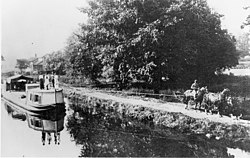Ohio and Erie Canal
|
Ohio and Erie Canal Historic District
|
|

The Ohio and Erie canal in 1902
|
|
| Location |
Independence and Valley View, Cuyahoga County, Ohio |
|---|---|
| Area | 24.5 acres (99,000 m2) |
| Built | 1825 |
| NRHP Reference # | 66000607 |
| Significant dates | |
| Added to NRHP | November 13, 1966 |
| Designated NHLD | November 13, 1966 |
The Ohio and Erie Canal was a canal constructed in the 1820s and early 1830s in the U.S. state of Ohio. It connected Akron, Summit County, with the Cuyahoga River near its mouth on Lake Erie in Cleveland, Cuyahoga County, and a few years later, with the Ohio River near Portsmouth, Scioto County, and then connections to other canal systems in Pennsylvania.
The canal carried freight traffic from 1827 to 1861, when the arrival of railroads killed the market. From 1862 to 1913, the canal served as a water source to industries and towns. In 1913, much of the canal system was abandoned after important parts were severely flooded.
Today, most of the remaining portions are managed by the National Park Service or Ohio Department of Natural Resources. They are used for various recreational purposes by the public, and still provide water for some industries. Parts of the canal are preserved, including the Ohio and Erie Canal Historic District, a National Historic Landmark.
Ohio, which achieved statehood in 1803, remained a sparsely populated region of 50,000 persons who were scattered throughout the state and who had no means of economically transporting goods. With no easy access to distant markets, agriculture served only local needs and large-scale manufacturing was nearly non-existent.
As early as 1787, George Washington and Thomas Jefferson had discussed the desirability of a canal linking Lake Erie to the Ohio River as part of a national system of canals. It wasn't until 1807 that Ohio's first Senator, Thomas Worthington offered a resolution in Congress asking Treasury Secretary Albert Gallatin to report to the Senate. In 1810, DeWitt Clinton was appointed to head the Erie Canal Commission. He was unsuccessful in his attempt to get national aid for the construction of a canal connecting Lake Erie to the Hudson River, so he enlisted the aid of state legislators and Ohio's congressional delegation. On January 15, 1812 the Ohio General Assembly passed a resolution expressing its view that the connection of the Great Lakes with the Hudson River was a project of "national concern". President Madison was against the proposal, however, and the War of 1812 ended all discussion.
...
Wikipedia


